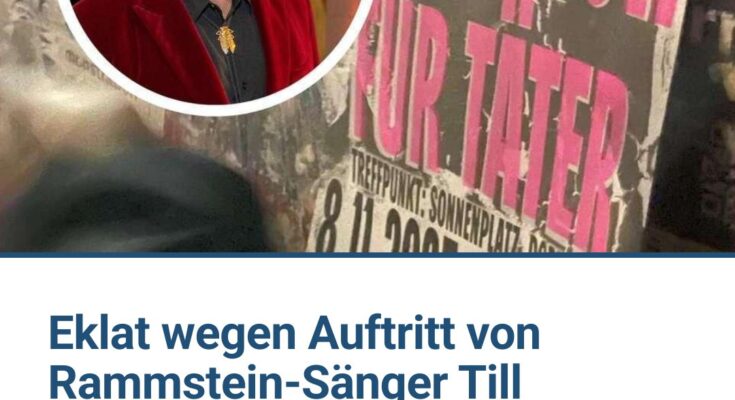“Till Lindemann Rocks Westfalenhalle in Dortmund Amid Controversy as Feminist Alliance Protests, While Loyal Fans Stand Firm in Support”
Till Lindemann, the unmistakable frontman of the legendary German industrial metal band Rammstein, took the stage at Westfalenhalle in Dortmund in a performance that will be remembered for years to come. Known for his deep, commanding voice, theatrical stage presence, and unapologetic artistry, Lindemann delivered a show that embodied the raw energy and spectacle Rammstein fans have come to expect. The concert, however, was not without controversy. A local feminist alliance had organized protests against the performance, citing concerns over the content and imagery often associated with Rammstein’s shows. Despite this, thousands of fans poured into Westfalenhalle, eager to experience a night of music, pyrotechnics, and the unparalleled charisma of one of metal’s most iconic figures.
From the moment Lindemann stepped onto the stage, the atmosphere was electric. Fans, many of whom had traveled from across Germany and neighboring countries, waved banners, cheered, and sang along to every song. Rammstein’s reputation for intense live performances is well-earned, with pyrotechnics, elaborate lighting, and choreographed theatrics forming an inseparable part of the experience. On this night, every flame, every note, and every dramatic gesture reinforced why Lindemann remains a central figure in the world of metal. The crowd’s energy was palpable, a vibrant contrast to the protests unfolding outside.
The feminist alliance that had voiced opposition to the show focused on the band’s history of controversial imagery and lyrics. Rammstein’s work has frequently pushed boundaries, exploring themes that some critics argue are provocative or offensive. The protestors argued that the performance was inappropriate and perpetuated harmful stereotypes, and they called on local authorities to reconsider permitting such events in public venues. Their presence outside Westfalenhalle was visible and vocal, yet it became clear that within the arena, fans were committed to enjoying the concert regardless of external pressures. Social media platforms were abuzz with discussions of the controversy, with both supporters and critics weighing in on the debate.
Inside the venue, the contrast between protest and performance highlighted the complexity of Lindemann’s public persona. On stage, he is a performer who thrives on theatricality and intensity, while off stage, he is often scrutinized for the cultural and social implications of his artistry. This duality creates a unique dynamic: fans view the performance as a celebration of music and artistic expression, while critics see an opportunity to challenge the limits of acceptable performance. Lindemann, in interviews and public appearances, has often defended his work as an exploration of human emotion, power, and societal taboos, asserting that art exists to provoke thought as much as to entertain.
The Dortmund concert featured a setlist that spanned Rammstein’s storied career, including iconic hits and fan favorites that drew the loudest reactions. The crowd’s enthusiasm never waned, with every song met by a wall of cheers, chants, and applause. Lindemann’s stage presence was magnetic, commanding attention with every movement and vocal inflection. Pyrotechnic effects punctuated key moments, sending bursts of fire and light into the audience and creating a sensory experience that few concerts can rival. Fans documented the performance on social media, sharing images and videos that captured the sheer scale and intensity of the show.
Amid the spectacle, the conversation surrounding the protests remained a persistent undercurrent. Supporters of Lindemann argued that music, particularly live performances, should not be censored or limited based on interpretations of artistic content. They emphasized the importance of personal responsibility and choice, noting that attendees willingly choose to experience Rammstein’s work, understanding its theatrical and often provocative nature. Critics, meanwhile, maintained that public venues carry a responsibility to consider community standards and the potential impact of controversial content. This ongoing tension between artistic freedom and social responsibility has followed Rammstein throughout their career, making each performance not just a concert, but a focal point for broader cultural discussion.
The Dortmund show also illustrated the loyalty and dedication of Rammstein’s fanbase. Many attendees had waited years to see the band live, and their commitment was evident in the energy and passion displayed throughout the evening. Fans of all ages and backgrounds came together, united by a shared love for Lindemann’s voice, the band’s signature sound, and the immersive theatrical experience that only Rammstein can provide. Merchandise booths were crowded, fans shared stories of past concerts, and the sense of community within Westfalenhalle was undeniable. Despite the protests outside, inside the arena, the music created a space where fans could revel in excitement, camaraderie, and shared appreciation for one of metal’s most enduring acts.
Lindemann’s interaction with the audience was both commanding and intimate. He acknowledged the crowd’s energy, gesturing and connecting with fans in ways that made each attendee feel a part of the spectacle. Moments of quiet intensity contrasted with explosive bursts of sound and light, creating a rhythm that kept the audience engaged from start to finish. His performance demonstrated why, despite controversy and criticism, Lindemann continues to be a magnetic force in the music world. The balance of artistry, theatrics, and vocal mastery was on full display, leaving an indelible impression on everyone present.
The protests outside Westfalenhalle served as a reminder that art rarely exists in a vacuum. Rammstein’s work, like that of many provocative artists, invites discussion and debate about societal norms, censorship, and the role of performance in public spaces. While some viewed the show as offensive or inappropriate, others celebrated it as a triumph of creativity and artistic expression. Lindemann himself has often stated that his intention is to challenge audiences, provoke thought, and evoke strong emotions, whether positive or negative. This approach, while controversial, has contributed to his lasting impact on the music industry and his reputation as a fearless performer willing to push boundaries.
As the night drew to a close, the energy within Westfalenhalle remained high. Fans left the venue exhilarated, discussing the performance, sharing memories, and planning for future concerts. The protestors, while still vocal outside, could not dampen the passion of a dedicated audience that had come to celebrate music and performance in its most intense form. Till Lindemann’s Dortmund concert was a testament to the enduring power of live music, the complexities of artistic expression, and the unwavering loyalty of fans who embrace the full spectrum of emotion and spectacle that Rammstein brings to the stage.
In the end, the show was more than just a concert; it was a cultural moment, a flashpoint where music, controversy, and fandom collided. Till Lindemann’s presence commanded attention, his performance demonstrated mastery of craft and spectacle, and the dialogue surrounding the event highlighted the ongoing tensions between artistic freedom and social critique. For fans, it was an unforgettable night; for critics, it was a reminder that Rammstein’s work continues to challenge and provoke. As the lights dimmed and the final notes echoed through Westfalenhalle, it was clear that Till Lindemann’s impact—both on stage and in broader cultural discourse—remains as powerful as ever, leaving audiences, supporters, and critics alike with something to reflect upon long after the last chord faded.



